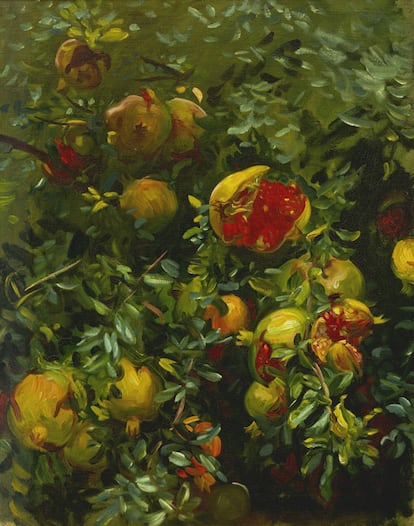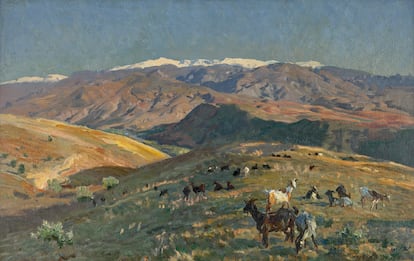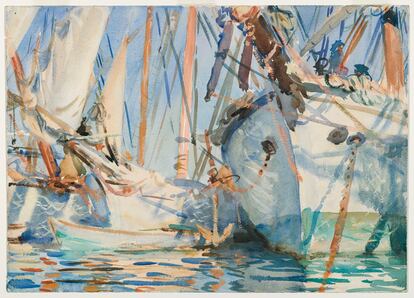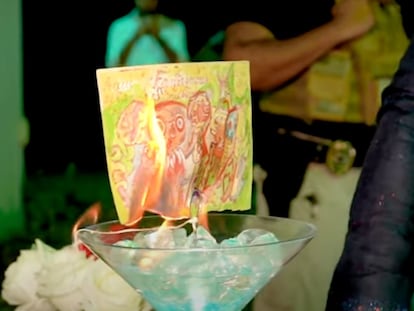Washington exhibition showcases John Singer Sargent’s fascination with Spain
The National Gallery of Art explores the Spanish footprint in the work of the renowned American painter who studied the great masters of the Prado Museum


His childhood as a somewhat nomadic expatriate trained the American painter John Singer Sargent (Florence, 1856-London, 1925) to become a tireless traveler. Spain was a destination that especially seduced him. He traveled to the country seven times between 1879 and 1912 and explored it from end to end at a time when getting around was not easy. Those trips, which included the study of the work of the masters Velázquez, Goya and El Greco, left a deep mark on his own painting.
The exhibition Sargent and Spain, recently opened at the National Gallery of Art in Washington DC, traces this fascination with the Iberian peninsula by an artist who is considered the best society portraitist of the late 19th and early 20th centuries.
Some of his masterpieces, such as El Jaleo or The Daughters of Edward Darley Boit were clearly inspired by Spanish art. The latter painting is sometimes referred to as Sargent’s version of Velázquez’s masterpiece Las meninas, which hangs at the Prado Museum in Madrid
The exhibition organized by the National Gallery of Art in collaboration with the Fine Arts Museum in San Francisco (where it will travel later) brings together 132 oil paintings, watercolors, drawings and photographs that cover the painter’s relationship with Spain. The show includes copies and personal interpretations of works by great Spanish masters, everyday scenes, portraits, landscapes and religious subject matter, along with sketches by the artist and photographs of the era.

“Sargent and Spain examines, for the first time, how Sargent engaged with that country in all its diversity, and represented it in paintings, drawings and photographs,” says Kaywin Feldman, director of the National Gallery of Art, in the catalog of the exhibition, which will be on view in Washington until January 2, 2023.
“His teacher and mentor Carolus-Duran told him: ‘Go to Madrid to study Velázquez, Velázquez and Velázquez.’ That is the beginning of the story,” said Sarah Cash, curator of the exhibition along with Richard Ormond and Elaine Kilmurray, on Tuesday. “Sargent fell in love with Spanish dance and music and also painted its architecture, its gardens, its landscapes, its culture and its people.”
The visit opens with Sargent’s immersion in Spanish painting. Emulating his admired Édouard Manet, he visited the Prado Museum and copied works by Velázquez, Goya and El Greco in reduced size. The exhibition includes, among others, his interpretations of Las Meninas, La fragua de Vulcano, Las hilanderas or La Trinidad. Unfortunately, The Daughters of Edward Darley Boit, on display at the Museum of Fine Arts, Boston, is not part of the exhibition. A few years ago, the meninas of both painters met at the Prado Museum. In any case, Velázquez’s influence is clearly appreciated in the dialogue established between his copy of Las Meninas and his Venetian Interior.
Sargent and Spain then dives into Spanish popular music and culture. Portraits of Carmen Dauset Moreno, La Carmencita, the composition The Spanish Dancer and numerous studies and sketches for El jaleo (the other missing masterpiece that would have made the exhibition truly complete) show how music and dance fascinated Sargent on his trips down south to Andalusia, although from those visits perhaps he drew a somewhat topical and romanticized portrait of the region. In the interest of political correctness, some works have been retitled: the original Spanish Gypsy Dancer has become Spanish Roma Dancer, and Gypsy Camp is now Spanish Roma housing.

The exhibition offers a journey back to the Spain of the time, part of which no longer exists and part of which is still the same. Sargent rejoiced in the architecture of the Alhambra and the Generalife in Granada, in the fountains of the royal palaces of Aranjuez and La Granja, the church of Santa María La Blanca in Toledo and the streets of Santiago de Compostela (Galicia) and Camprodón (Girona). But he also painted the landscapes of Sierra Nevada, gardens, everyday scenes and a variety of portraits. He set up his easel inside a stable in Cuenca, in a hospital in Granada, in front of the house of a Roma family, and among groups of soldiers.
But it was the island of Mallorca that particularly captivated him. He painted the cathedral of Palma and captured the landscape with its olive trees, its flowers, its gourds and its animals. The light and color of his watercolors depicting fishing boats bring him close to the work of renowned Mediterranean artist Joaquín Sorolla. The trees full of pomegranates, which he painted in oils and watercolors in Mallorca, were later imported into the imposing series of murals The Triumph of Religion at the Boston Public Library.

A contemporary of Joaquín Sorolla (they dedicated paintings to one another), there were some parallels between the two: both were successful painters in their own time, both were later somewhat underestimated with the introduction of 20th-century avant-garde movements, and their work was later vindicated. Both were determined to achieve a modern style of painting based on the naturalist tradition. Sargent was a great portraitist of the American and European bourgeoisie, as evidenced by some of his masterpieces, such as Madame X, kept at the New York Metropolitan Museum of Art.
Sargent, an American who never settled in his country but who valued his US citizenship, traveled back and forth to Spain over three decades, usually from London or Paris. He first came as a young artist, then as an established and sought-after painter, worldly and cosmopolitan. The exhibition ends with a section dedicated to his work inspired by religion.
To make the most of the interest in Spain sparked by the exhibition, a series of cultural activities have been organized in collaboration with the Spanish Embassy in Washington, including conferences, a cycle of documentaries, films and a concert that highlight the culture that so fascinated the painter. “Sargent fell in love with Spain”, summarized the embassy’s cultural adviser, Miguel Albero.
‘Sargent and Spain’ is on view from October 3, 2022 to February 2, 2023 at the National Gallery of Art in Washington DC and from February 11 to May 14, 2023 at the Fine Arts Museum in San Francisco.
Tu suscripción se está usando en otro dispositivo
¿Quieres añadir otro usuario a tu suscripción?
Si continúas leyendo en este dispositivo, no se podrá leer en el otro.
FlechaTu suscripción se está usando en otro dispositivo y solo puedes acceder a EL PAÍS desde un dispositivo a la vez.
Si quieres compartir tu cuenta, cambia tu suscripción a la modalidad Premium, así podrás añadir otro usuario. Cada uno accederá con su propia cuenta de email, lo que os permitirá personalizar vuestra experiencia en EL PAÍS.
¿Tienes una suscripción de empresa? Accede aquí para contratar más cuentas.
En el caso de no saber quién está usando tu cuenta, te recomendamos cambiar tu contraseña aquí.
Si decides continuar compartiendo tu cuenta, este mensaje se mostrará en tu dispositivo y en el de la otra persona que está usando tu cuenta de forma indefinida, afectando a tu experiencia de lectura. Puedes consultar aquí los términos y condiciones de la suscripción digital.
More information
Últimas noticias
A survivor’s account of the Interoceanic Train accident: ‘We were scared because of the speed on the curve’
The Interoceanic Train, the Mexican alternative to the Panama Canal
What is known about the Interoceanic Train derailment in Oaxaca
Trump turns a Minnesota fraud allegation into ammunition for his MAGA army against Democrats
Most viewed
- Oona Chaplin: ‘I told James Cameron that I was living in a treehouse and starting a permaculture project with a friend’
- Reinhard Genzel, Nobel laureate in physics: ‘One-minute videos will never give you the truth’
- Why the price of coffee has skyrocketed: from Brazilian plantations to specialty coffee houses
- Pablo Escobar’s hippos: A serious environmental problem, 40 years on
- Chevy Chase, the beloved comedian who was a monster off camera: ‘Not everyone hated him, just the people who’ve worked with him’










































